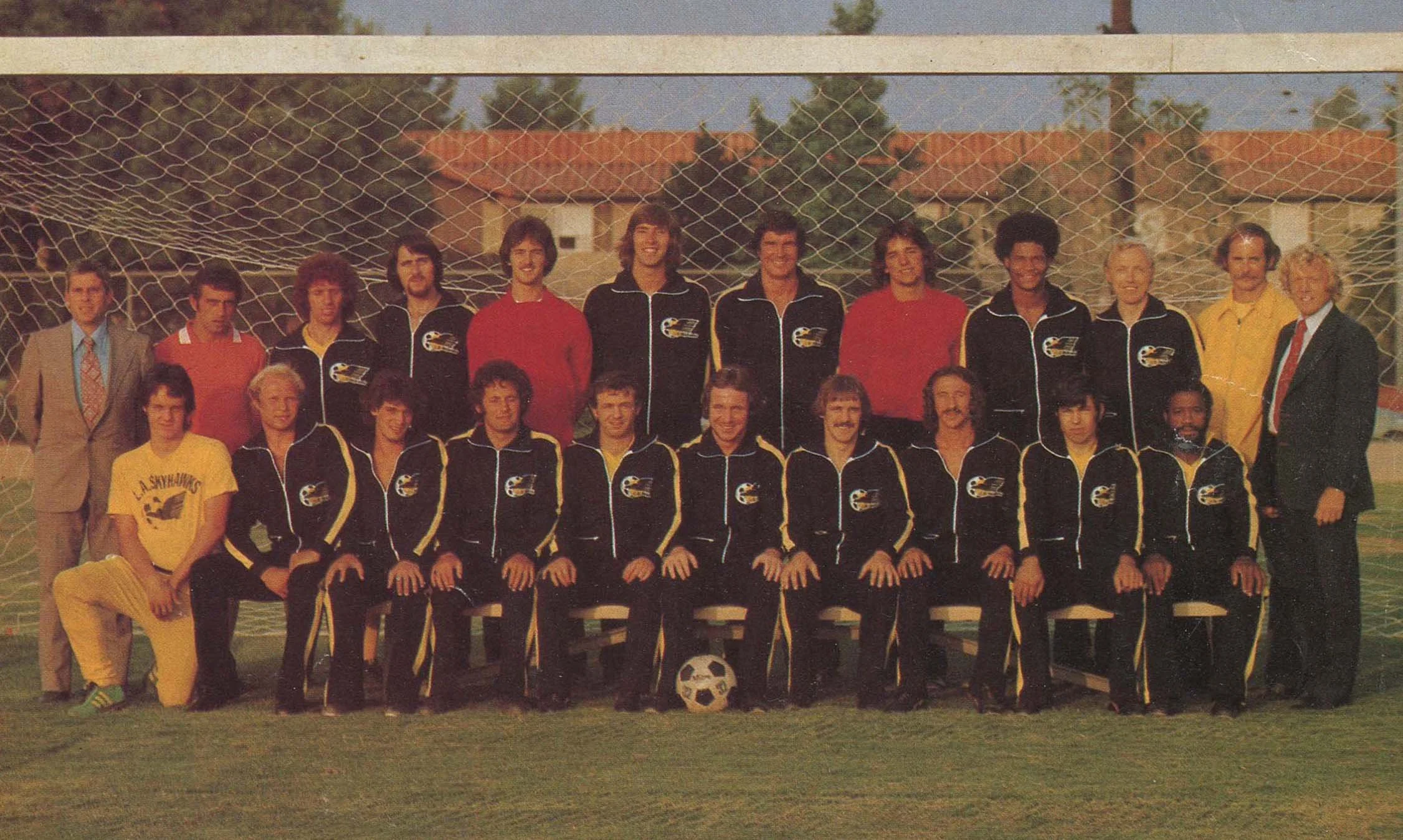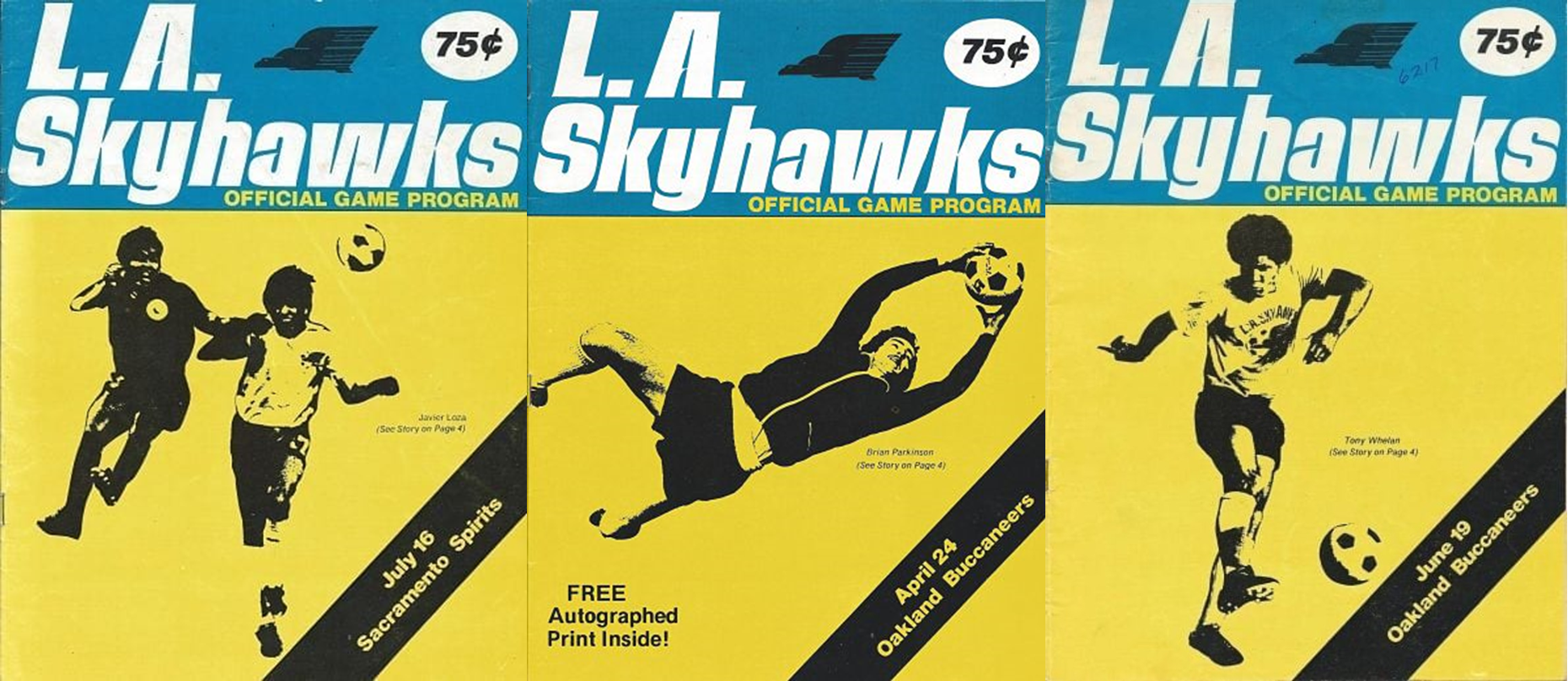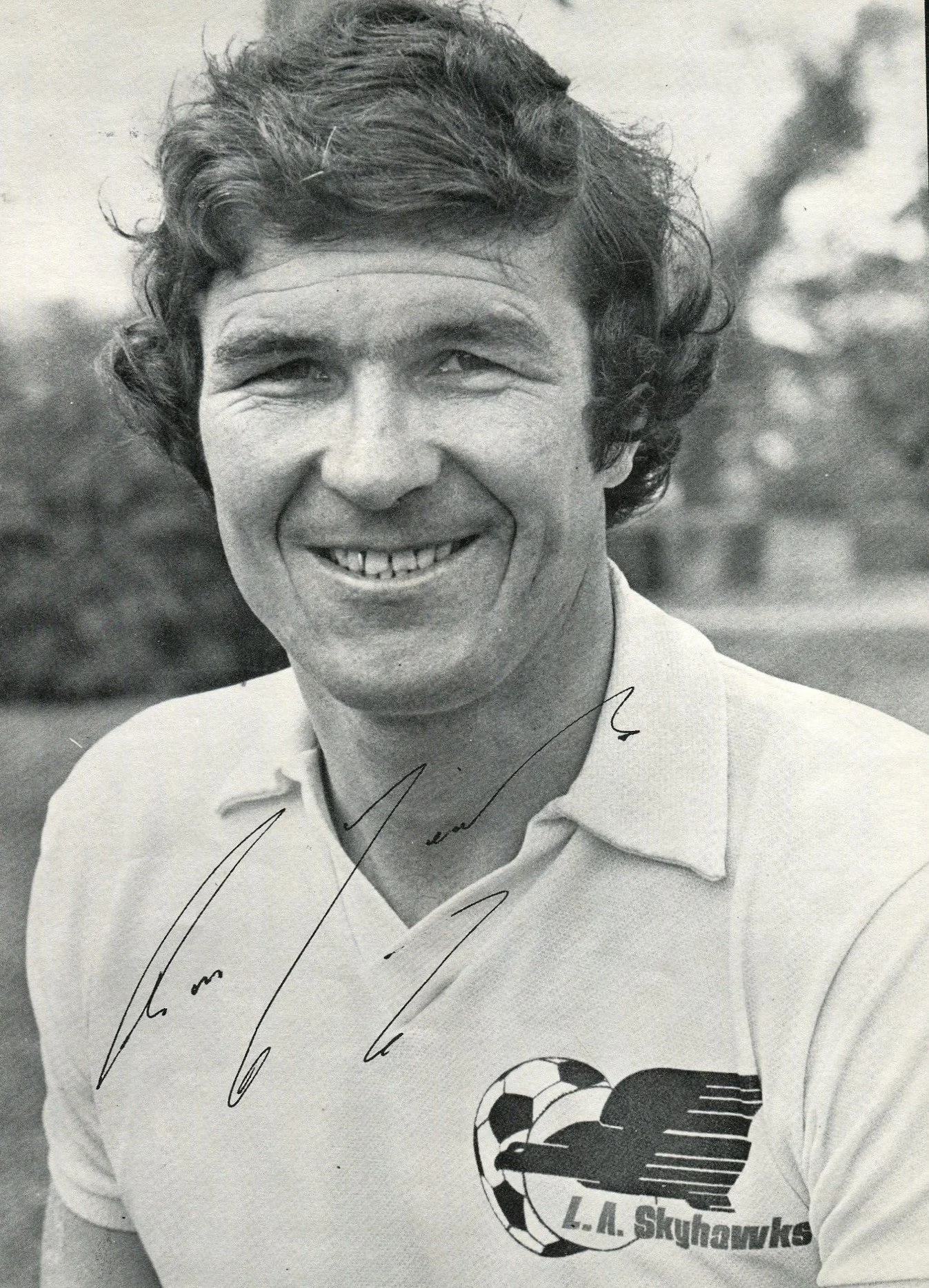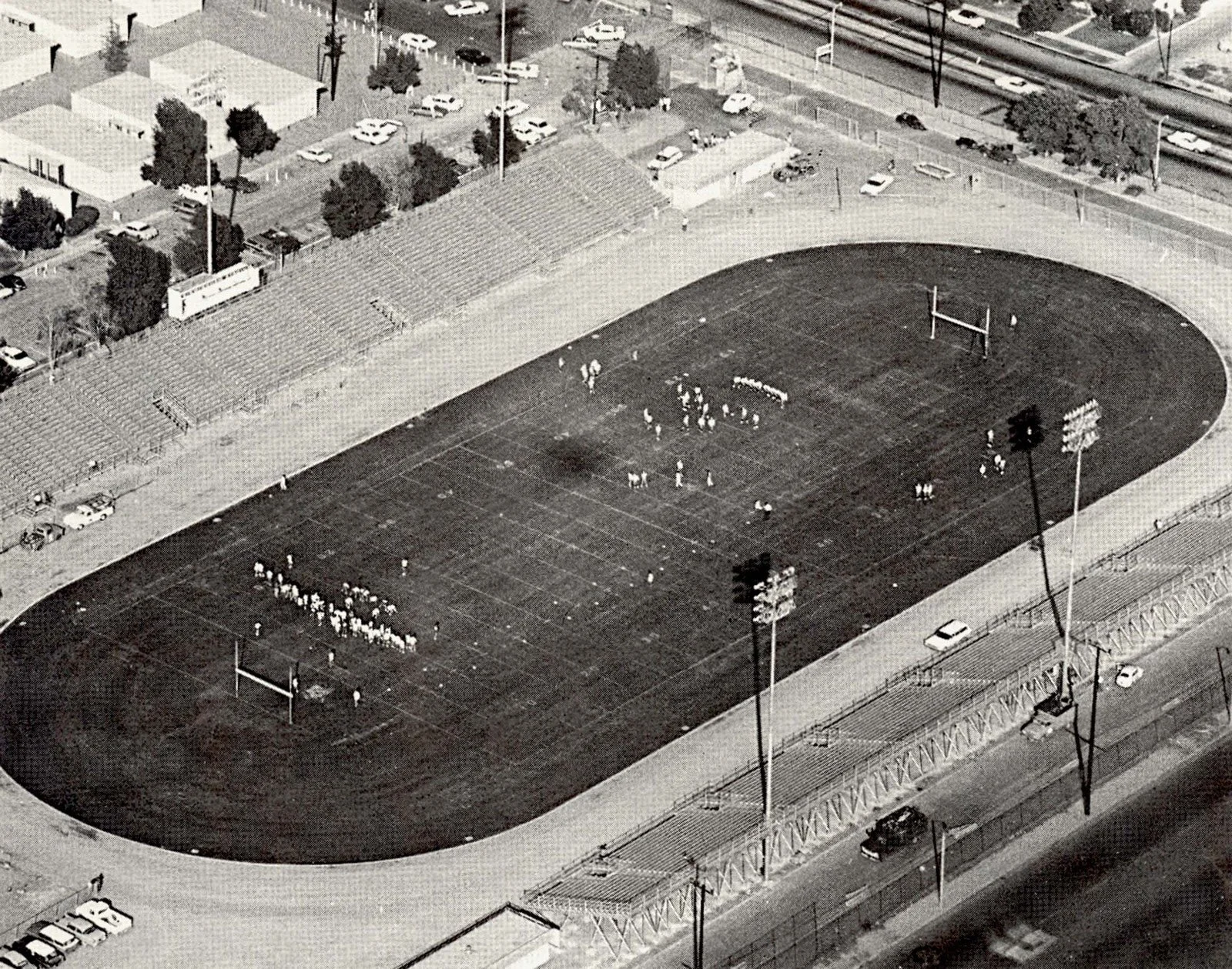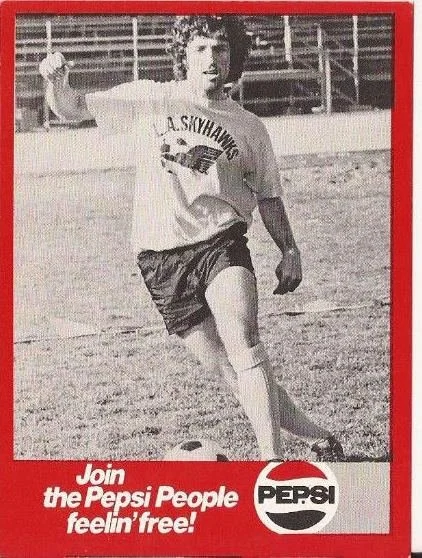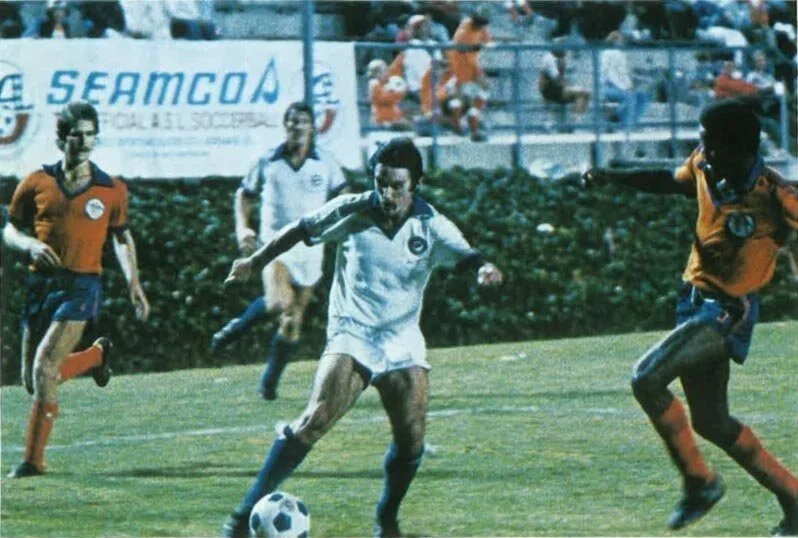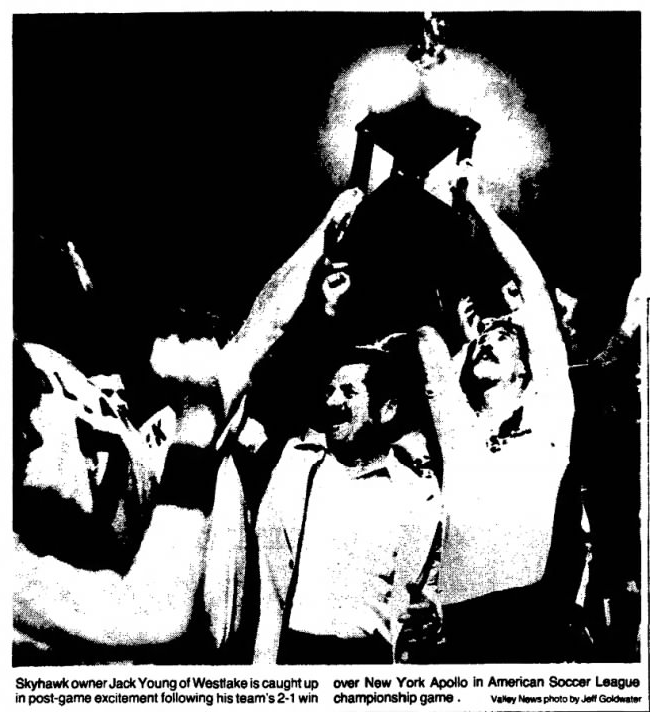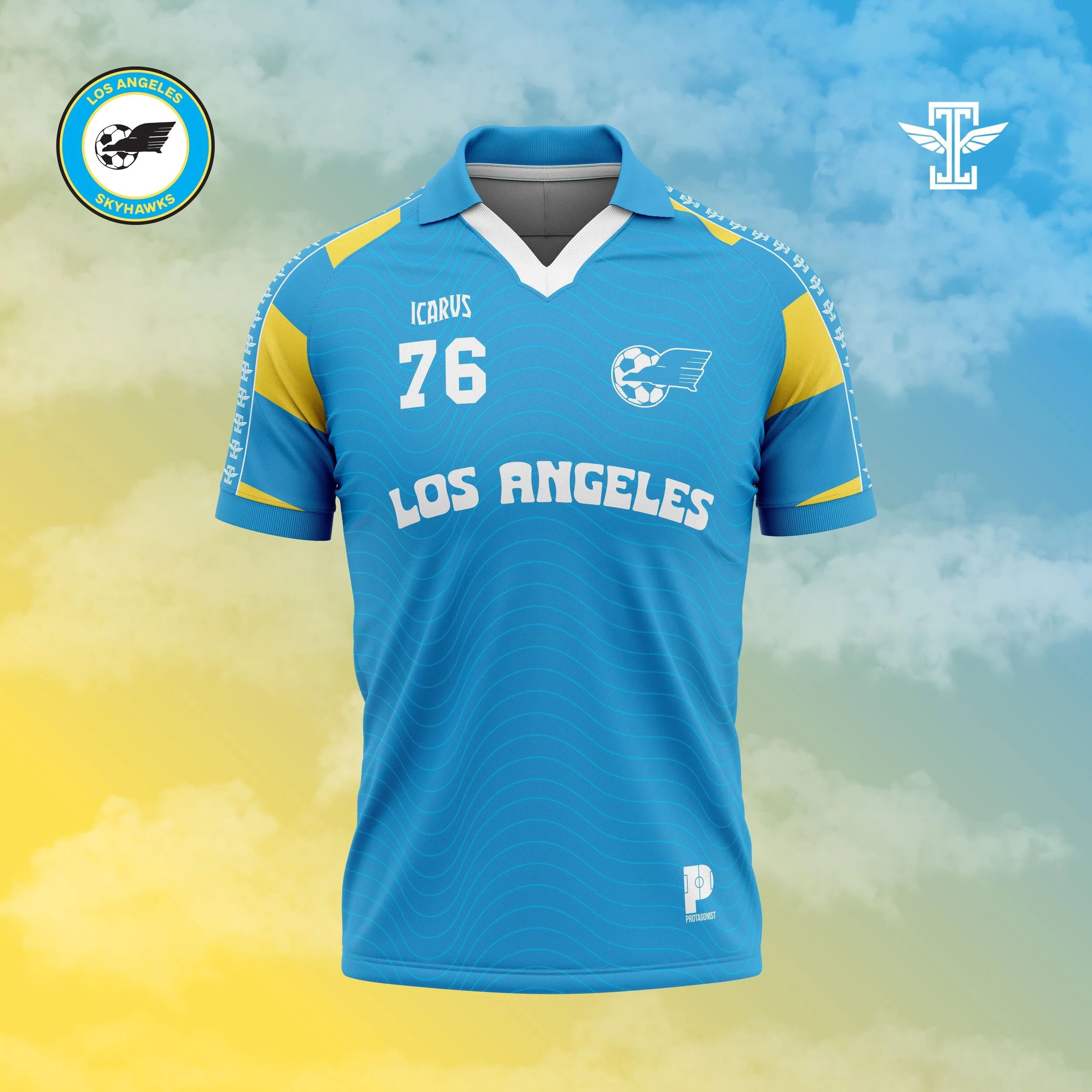Kicking Back: L.A. Skyhawks - Champions, 1976
Forty-five years ago the promise of soccer as a major sport in the United States seemed close to becoming a reality. The North American Soccer League, born nearly ten years earlier in the wake of the popularity of the 1966 World Cup, was expecting its most successful season. Down to five teams and on the verge of collapse in 1969, the league had stabilized in the intervening years and was up to 20 teams by its 1976 season. A national television deal beginning in 1974, the signing of Pele by the New York Cosmos midway through the 1975 season, and the signing of George Best by the Los Angeles Aztecs before the 1976 season were indications that the league and the sport were on the path to a level of mainstream acceptance that sports business interests had been hoping for.
This excitement wasn’t just confined to the NASL. In 1976, the American Soccer League sat a rung below the NASL in the US professional soccer landscape. While much older than the NASL, the ASL was, in the mid-seventies, a minor pro soccer league located primarily on the east coast. But, the ASL’s status belied its deep history in the game.
Formed in 1921, the ASL, based solely in the northeast and mid-Atlantic, was the first modern attempt to build a major soccer league in the mold of the big baseball circuits. At that time, soccer was a hugely popular sport with big matches regularly bringing in crowds in the tens of thousands. And the ASL clubs were able to bring over top footballing talent from Scotland and England due to the high salaries they were able to offer.
The league did well over its first half dozen years before infighting and a power struggle with the U.S. Football Association and the various state leagues caused a schism in the pro ranks. In 1928, the ASL became an outlaw league when the USFA removed its sanctioning and launched its own pro league, the Eastern Soccer League. The USFA ultimately won the battle with the ASL being replaced by the Atlantic Coast Soccer League - practically a merger of the ASL and ESL. But the merger happened a week before Black Monday plunging the country into the Great Depression.
The combination of bad blood and bad luck was the end of the ASL (which returned after the ACSL's only season) as a true major sports league. The circuit stumbled through a few chaotic seasons before being reorganized in the fall of 1933 as a more traditional league on a reasonable financial footing. From the 1930s through the 1950s the ASL was still considered the “big pro league” in US soccer even though it was not at the same level as major league baseball and college football.
While other sports, such as basketball, pro football, and hockey, gained major league status in the post-war era, soccer was never able to make that transition. The ASL, and the sport itself, began to quickly drift away from the mainstream sports consciousness. It was such a relatively quick deterioration that, by the time of the 1966 World Cup, many US newspapers only thought of the sport as a game played by colleges and a few youth organizations.
At that point, the makeup of the ASL was basically the same as it had been since the 1930s - an aggregation of clubs from the northeast mostly sponsored by ethnic community organizations. Over that time, though, a transition had taken place where the circuit moved from a solidly professional to a mostly semi-pro concern.
Similar to the NASL, the ASL was on the cusp of near-extinction with only five clubs in its roster during the 1970 and 1971 seasons. In a matter of a few years, the league lost all of its stable, ethnic clubs (including the legendary Ukrainian Nationals of Philadelphia) and, with the 1972 season, practically became a traditional US minor league. The league nearly tripled in size that season as it brought in a raft of expansion franchises and moved into the midwest for the first time in its history. Most of these expansion teams failed to make it past their first season, but the push to make the ASL a national league continued.
In another step towards Americanization, before the 1975 season, the ASL hired basketball great Bob Cousy as its first true commissioner. Cousy famously knew nothing about soccer and did little to learn about the sport during his time in that role. With Cousy installed as their figurehead leader, the league hoped for greater press coverage during the NASL era.
The ASL looked to continue a new phase of its growth in the 1976 season. While a minor league in relation to the high-spending NASL, the ASL was making moves in hopes to become a competitor to the NASL for the expanding US soccer viewership and dollar. For the first time in its history, it truly became a national league when it added five clubs on the west coast. Joining more established clubs in New York and Cleveland (which had only been in the league a handful of years each) were clubs in Oakland, Sacramento, Tacoma, Salt Lake City, and Los Angeles.
With a franchise formally based in the San Fernando Valley, the Los Angeles Skyhawks were co-owned by real estate developer Jack Young of Westlake Village, and Ralph Smith of Brentwood. The pair hoped to compete with the NASL’s Los Angeles Aztecs and saw the relatively low cost of the ASL as a way to do so. The ASL’s expansion fee of $80,000 was low compared to the NASL’s mid- to high-six figure fees of the time. The ASL’s low salary and overhead costs also appealed to Skyhawks’ owners.
The Skyhawks hit the ground running by hiring Ron Newman as their head coach. Newman had been player-coach of the NASL’s Dallas Tornado since 1969 and had won the league championship in 1971 before being fired after the 1975 season. He made an immediate impact on the ASL when the league approved a new points system he devised. The league had always determined team rankings via the traditional system of awarding two points for a win and one point for a draw. Starting in the 1976 season, the ASL implemented the “Newman System''. Under that system teams received five points for a win, two points for a draw, and one bonus point per goal up to a maximum of three points each game. The league also implemented the playing of two 10-minute sudden-death overtime periods if a game was tied at the end of regulation.
Newman’s presence as coach also helped bring in top-quality players. Both the NASL and ASL held drafts during the seventies and Steve Ralbovsky, 1975 Hermann Trophy winner from Brown University, was drafted first overall in both leagues’ 1976 drafts. Ralbovsky decided to sign with the Skyhawks over the Los Angeles Aztecs of the NASL because the ASL offered him a higher compensation package. The Skyhawks were also able to sign their second-round pick, defender Brooks Cryder from Philadelphia Textile, who had also been drafted in the first-round by the NASL’s Philadelphia Atoms.
Unlike most ASL clubs of the time, which relied on young US players along with journeymen non-Americans, the Skyhawks invested heavily on salaries. With Newman’s connections, the club brought in a large number of players from the English leagues on loan for the summer. Perhaps more impressive was Newman’s ability to acquire those players given the roster strictures imposed by the league. As part of the sport’s movement toward Americanization, the ASL restricted the number of non-Americans on each club's roster to seven players. Newman was able to maximize the worth of those limited resources while also acquiring players who were dual nationals or whose residency status meant they didn’t take up a foreign roster spot.
Their captain was Ron Yeats, an imposing 6’2” over 200 pound-defender who had previously led Liverpool F.C. to an FA Cup and two First Division championships in the 1960s. Yeats arrived on loan from Barrow A.F.C. Brian Parkinson was signed from Everton where he had been a backup goalkeeper. Defender, Ken Fogarty, was brought in on loan from Stockport County F.C. These three players formed the backbone of a defense that stifled opposing offenses the entire 1976 season.
On the offensive side, the biggest pickups were forwards Jimmy Hinch and Jimmy Rolland. Hinch arrived on loan (along with midfielder, Micky Cave) from York City F.C. Rolland, a Scotsman, came to the Skyhawks from Northwich Victoria F.C. Hinch and Rolland would form a devastating one-two punch that would lead the Skyhawks’ offense. In addition, midfielder Tony Whelan arrived on loan from Rochdale A.F.C. and gave the club a third goal-scoring option when most other teams only could rely on one.
The Skyhawks began the season in mediocre fashion with three draws against fellow west coast expansion clubs. On April 17, the team’s first match ended in a scoreless draw against the Sacramento Spirits at Birmingham High School. While the score was uninspiring, the Skyhawks’ defense shined and an attendance of 4139 at the Van Nuys venue was a good number in comparison to the Aztecs (which averaged around 8000 that season at El Camino College in Torrance).
The Skyhawk played a pair of 1-1 ties in their next two games at home against the Oakland Buccaneers and Tacoma Tides. The Skyhawks’ following game was on May 1, a day after their prior match against Tacoma, as they traveled to play the Utah Golden Spikers at Rice Stadium. It was Utah’s very first match and an impressive crowd of 8,000 saw the Skyhawks win their first match 1-0 on a Jimmy Rolland goal.
Hinch scored a brace in their next match as the club won 2-1 at Cheney Stadium in Tacoma. The club made it three in a row by blanking Utah 3-0 at home on goals by Hinch, Rolland, and Whelan. The Skyhawks stumbled in their next match losing their first of the season 2-1 to Oakland at Edwards Field on the campus of UC Berkeley. But, even with that loss, as of late May, the Skyhawks were leading the ASL’s Western Division with 30 points to Tacoma’s 27 points.
Ron Yeats, former Dundee United and Liverpool hero at LA Skyhawks in 1976
After the loss to Oakland, and looking to improve his defense, Newman traded Brooks Cryder to the Tacoma Tides for another defender, Altamont McKenzie. "Alty" had been drafted by the Dallas Tornado in 1974 and played for Newman during his last two years with the club. McKenzie would become a mainstay for the Skyhawks and later play for the Jamaican national team.
Because of the odd number of teams in the league, the ASL brought in Cork Hibernians F.C. on tour from the League of Ireland. The Hibernians would play each ASL club once during the season with the results counting in the final standings. Cork had won the League of Ireland title in the 1970-71 season and was regularly in the top half of the standings.
The Skyhawks played the Hibs at home on May 29 and crushed the Irish squad 4-0 in front of 6327 fans. Micky Cave and Rolland scored goals as well as two American players, Jerry Kazarian and Ane Mihailovich. Kazarian was an Armenian-American from Los Angeles who had spent the past couple of seasons on the bench with the Los Angeles Aztecs and San Jose Earthquakes of the NASL. Mihailovich had spent the previous two years in the ASL with the Detroit Mustangs and Cleveland Cobras before landing with the Skyhawks.
In order to cut down on expenses, the ASL planned to have teams make only one road trip to play teams in the other division. The Skyhawks’ first match against an Eastern Division opponent would be on June 5 against the Connecticut Yankees at Dillon Stadium in Hartford. The Yankees had the best offense in the league and handled the Skyhawks 2-1 in front of a tiny crowd of 500.
A few days later the Skyhawks met the New York Apollo at Hofstra Stadium on Long Island. Known as the Greeks in their first two seasons, New York was the best team in the ASL during the 1970s. The club had won their division every year since joining the league in 1971. The Apollo had won three championships, and made it to the finals in the club's other two seasons.
In 1975, New York was co-champions with the Boston Astros. In the league finals for that season, the clubs went into sudden-death overtime after tying on aggregate goals over two legs. After nine scoreless sudden-death periods, commissioner Cousy suspended play and named both clubs co-champs of the 1975 season.
Defense and another Rolland goal won the day for the Skyhawks as they downed the Apollo 1-0. The final game of LA’s east coast trip saw the club fight to a scoreless draw with the Rhode Island Oceaneers at Pierce Memorial Stadium in East Providence on June 11.
The Skyhawks returned home the next week and hosted their first Eastern Division opponent. LA had no trouble with the New Jersey Americans, blanking the expansion club 4-0 with goals by Rolland, Whelan, Hinch, and Leif Werneid in front of 6474. The latter player was a Norwegian footballer who had come to the states to play with the Los Angeles Wolves in the inaugural season of the NASL in 1968 and ended up staying in the Los Angeles area.
Birmingham High School Stadium, Los Angeles, CA - photo as it was, 1967
A few days later the Skyhawks hosted the renamed Golden Bay Buccaneers. Midway through the season, the Buccs had moved from Oakland to Fremont due to financial difficulties and an ownership change. The clubs drew 1-1 at Birmingham High in front of 6217.
The next match for the Los Angeles squad was a Pacific Coast Cup exhibition against the Sacramento Spirits at Hornet Field on the campus of Sacramento State. The cup was an additional competition created that season to be held among the ASL’s Western Division teams. The Spirits won that match 1-0.
The Skyhawks played two games away during the first week of July winning both. In the first, they blanked Golden Bay 1-0 at Tak Fudenna Stadium in Fremont. And, in the second, they edged Sacramento 4-3 on an overtime goal by Ane Mihailovich at Hornet Field.
Los Angeles’ next game was a friendly and an important test for the team. The club played the Mexico Olympic team on July 9 at the Los Angeles Coliseum with 9652 in attendance. The Mexicans were playing a number of tune-ups before they began group play at the Montreal Olympics. Jimmy Hinch tied the score 1-1 in the first half and Jimmy Rolland put the Skyhawks up 2-1 early in the second. But the Mexicans tied the score and eventually won 3-2 on a Victor Rangel goal with six minutes left to play.
Even given that loss, the Skyhawks were a success both on and off the field. The club was pulling away with both the Western Division and overall league lead in points. And the Birmingham High School Stadium crowds rivaled those in the middle of the NASL pack. Things were looking rosy for the Skyhawks.
But the same couldn’t be said for the ASL overall. With a month to go in the regular season, a number of clubs, and the league itself, were in financial straits. In mid-July, the issues started to pile up. The league suspended inter-division play for the remainder of the season and began a scramble to revise the schedule. An all-star game planned for August 1 was also scrapped. Four of the five Western Division teams were in arrears in league dues and other obligations to the tune of $150,000 total. Only Tacoma was up to date in their payments. And, while the Skyhawks were behind in their payments, their financial situation was good enough to pay off the debt. Other clubs weren’t in the same situation.
After their initial majority owner left the club holding over $100,000 in debt, the Buccaneers were taken over by a group of local businessmen. That group barely kept the team afloat and needed regular help from other investors to keep the team going. Eventually, the club ran out of money near the end of the season leading the league to cancel its final couple of games.
Similarly, the Sacramento Spirits were in financial trouble most of the last half of the season. The club found itself $200,000 in debt at one point and had not paid salaries. An influx of new investment helped the club stay afloat through the competition.
LA Skyhawks’ Abraham Cohen from a team card set
The most fraught situation likely laid with the Utah franchise. Initially, the ASL had approved a franchise in San Diego, but that franchise folded just before the season started. A Salt Lake businessman purchased the franchise and moved it to Utah in March and quickly tried to build a club. The endeavor immediately met troubles getting approval to use the Utah State Fairgrounds as its home field. Less than a month into the season the majority owner was ousted by others in the ownership group led by Tim Themy but the club quickly ran out of money.
After a match at Salt Lake, Themy got into a physical altercation with ASL president, Nick Sclavonous. With the club in debt to the league and that fight on their minds, in early July, the league suspended Themy and attempted to get him to resign from the league. After Themy refused, the ASL then expelled the Golden Spikers franchise from the league in early August. The league then awarded a completely new franchise, called the Utah Pioneers, to a new ownership group that inherited the Golden Spikers’ record and took over that club’s schedule.
Among all the financial and organizational chaos of the league, Ron Newman kept the Skyhawks on an even keel in their march to the playoffs. Newman was even able to handle a number of personnel issues that might have otherwise sunk the team. He lost the services of Ron Yeats for the better part of July when his captain had to return to England on personal business. In addition, starting goalkeeper, Brain Parkinson, hurt his knee in the game against Rhode Island on June 11. The injury was bad enough to keep Parkinson out of action for the rest of June and most of July. Backup keeper, Marine Cano, was a 22-year old American getting his first pro experience and who had played at Bishop Montgomery High School in Torrance. Cano, and the Skyhawks, managed the transition admirably winning five games and drawing one in his six starts.
Originally scheduled to play the New York Apollo at home, the ASL’s suspension of inter-division play meant the Skyhawks would instead face the Sacramento Spirits on July 16. Sacramento was able to keep the Skyhawks’ offensive stars from scoring but Los Angeles’ depth was too much as they beat the Spirits 2-0 on goals by Alty McKenzie and Moishe Hoftman.
In their next game, the Golden Spikers replaced the scheduled Chicago Cats. The Skyhawks continued to roll with a 1-0 win on a Jimmy Rolland goal in front of 5433 at Birmingham High School Stadium. The Skyhawks hosted the Golden Spikers ten days later and the match was more lopsided than the last. Brian Parkinson returned in goal as Los Angeles blanked Utah 3-0 in front of 5127 at home.
At the beginning of August, the Skyhawks were on cruise control with the playoffs only three weeks away. On August 7, Los Angeles beat the Spirits at Hornet Field 5-2 on the back of a hat trick by Jimmy Hinch and a brace by Jimmy Rolland. The Cleveland Cobras were due to play the Skyhawks at Birmingham High School two days later. But the Cleveland team had left California after playing Golden Bay on August 8. That left Los Angeles without an opponent after the club had sold 7000 advanced tickets. Sacramento stepped in and took the contest on less than 12 hours’ notice. The result was much the same as before with the Skyhawks dominating 4-1. This time it was Hinch with the hat trick and Rolland scoring the other goal in front of 7437 at Birmingham High.
Skyhawks Forward, Jim Rolland, 1978 (photo: Frank Tromba)
The Skyhawks’ final regular-season game was on August 13 against the new Utah Pioneers franchise at Cottonwood High School in Murray. Amid all the chaos, the Utah franchise kept up as a competitive squad and had managed to make the playoffs. Los Angeles was assured of a bye by taking the Western Division title and took their foot off the pedal a bit. The result was a 1-1 draw with the Skyhawks’ goal coming from forward Doug McMillan.
McMillan, a Scottish-American, had joined the Skyhawks at the end of July after being cut by the Los Angeles Aztecs during their season. McMillan had been the ASL Rookie of the Year in 1973 playing for the Cleveland Stars (the original name of the Cleveland Cobras) and was named NASL’s Rookie of the Year the very next season as he helped the Aztecs win the championship in their first season. McMillan had been brought on board by Newman because the Skyhawks’ would be needing his services for the playoffs.
Because of the terms of their loans Tony Whelan, Ken Fogarty, and Micky Cave had to return to their English clubs before the Skyhawks started the playoffs. On top of that, Ron Yeats had injured his back and was going to be unavailable for the club’s run to the championship.
The Skyhawks had a week’s rest as they waited for their opponent to be decided by the result of a Divisional Semifinal match. In that game, the Tacoma Tides edged the Utah Pioneers 2-1 and would meet the Skyhawks on August 21 at Birmingham High School.
After Los Angeles, the Tides were the most stable Western Division team helped in large part by being co-owned by the Tacoma Twins minor league baseball club and Booth Gardner. The club had the league’s second best record after the Skyhawks and was a strong contender to score an upset.
With longtime vet Jamil Canal hobbled by injury, Tacoma’s man in goal was their backup keeper, Bruce Arena. The Tides had hired Cornell University coach, Dan Wood, to lead the team and Wood reached out to his former player, Arena, an All-American at Cornell, to join him in Tacoma. In front of 7778 fans, the game was a defensive battle and remained scoreless well into the second half.
Alty McKenzie put the Skyhawks on the board first in the 66th minute. McKenzie took a pass from Abe Cohen and beat Arena from 20 yards out. Bolivian-American Windsor de Llano tied the score for the Tides in the 83rd minute on an assist by Wolfgang Gartner. With no further score in regulation, the match went into the first 10-minute sudden death overtime period. Five minutes in, McMillan sent a perfect pass to Jimmy Rolland who put the ball into the back of the net. The Skyhawks won 2-1 and would meet defending champion New York Apollo in the championship match.
After the game, Doug McMillan stated “[The Skyhawks] are at least two goals better than the Aztec team that won the NASL championship [in 1974]. The teamwork here is incredible. There’s nothing like it in any level of soccer in the US.” (The Daily Breeze. 22 August 1976. p. E6.)
The 1976 ASL Championship was held on August 27 at Birmingham High School between the New York Apollo, the 1975 champions, and the Skyhawks before a season-high crowd of 9379. The game was another classic battle.
In the 38th minute, New York forward, Danny Doran, scored first. In the leadup to the goal, Skyhawks’ keeper, Brian Parkinson, blocked a shot by Ted Nahorski leaving him on his back. Doran corralled the rebound and shot the ball into the open goal.
The Skyhawks found themselves in dire straits late in the first half. Alty McKenzie was pestered by the Apollo players including being tripped four times. After being knocked down by defender Dave Power, McKenzie finally retaliated, causing midfielder Carlos Ravel to take a dive as if he had been punched in the face. McKenzie received a red card from referee Artie Wachter which meant the Skyhawks would be down a man for the entire second half.
Los Angeles persevered and, in the 70th minute, Jimmy Hinch, the ASL’s leading scorer, took a pass from Jimmy Rolland’s head and scored with his left foot from 17 yards out, tying the score 1-1. Then, in the 83rd minute, Skyhawks midfielder Steve Ralbovsky was fouled by Peter Christofordies in front of the Apollo goal. Ane Mihailovich scored on the ensuing penalty kick past Gerard Joseph, the New York goalkeeper, putting the Skyhawks up 2-1. Los Angeles was able to run out the rest of the clock ending a dominant season as the 1976 ASL champs.
Newman would rejoin the NASL in the offseason signing on to coach the Miami Toros (which was quickly renamed the Fort Lauderdale Strikers). He would eventually join the San Diego Sockers as the team transitioned from the NASL to the Major Indoor Soccer League. His Sockers dynasty would win two NASL indoor championships and eight MISL championships over the span of 12 seasons in the late eighties and early nineties.
The Skyhawks would keep a core group of players together and stayed competitive over the next few seasons. The club would make it to ASL finals again in 1978 before losing 1-0 to the New York Apollo. The club would play one more season before the costs of running a minor league soccer club forced them to fold prior to the 1980 season.
But 1976 was special. That year the Skyhawks had a record of 13 wins, 6 draws and 2 losses during the regular season. The offense scored 41 goals and only gave up 15 for a gaudy differential of 26. Arguably the best soccer coach in the US at the time, Ron Newman was named Coach of the Year, an award he also won in the NASL. His win with the Skyhawks made him the only coach to win both the NASL and ASL championships. Jimmy Hinch was the ASL’s top scorer with 13 goals and six assists, and was named league MVP. The club also boasted five all-stars on their roster: Hinch; Rolland (with 11 goals and four assists); Brian Parkinson; Ken Fogarty; and Ron Yeats.
Even though they languished in the American Soccer League away from the media glare of the NASL, the 1976 Los Angeles Skyhawks were one of the best US teams of their era. Ron Newman himself regularly called the squad the best team in the US that season. Brian Parkinson said it was the best team he had ever played on. The club captured lightning in the bottle: the right place; the right front office; the right head coach; and the right mixture of players. In 1976 the sky was the limit for US soccer and an expansion club from the San Fernando Valley playing in the minor leagues was the epitome of that marvelous future waiting right around the corner.
- Dan Creel
Check out our replica kit by Icarus FC - available HERE

